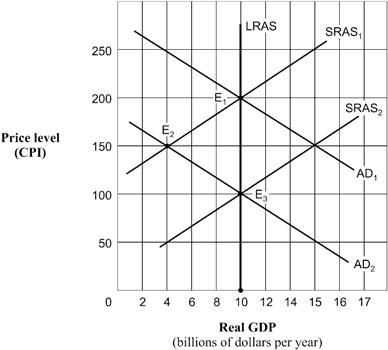Multiple Choice
Exhibit 14A-6 Aggregate demand and supply model  Beginning from a point of short-run equilibrium at point E2 in Exhibit 14A-6, the economy's movement to a new position of long-run equilibrium from that point would best be described as:
Beginning from a point of short-run equilibrium at point E2 in Exhibit 14A-6, the economy's movement to a new position of long-run equilibrium from that point would best be described as:
A) a movement along the AD2 curve caused by a shift in the SRAS1 curve to SRAS2.
B) a movement along the SRAS2 curve with a shift in the AD2 curve.
C) a shift in the LRAS curve to an intersection at E3.
D) no shift of any kind.
Correct Answer:

Verified
Correct Answer:
Verified
Q22: Long-run full-employment equilibrium assumes:<br>A) a downward-sloping production
Q71: In long-run full-employment equilibrium, which of the
Q73: Exhibit 14A-3 Macro AD-AS Model <img src="https://d2lvgg3v3hfg70.cloudfront.net/TBX9287/.jpg" alt="Exhibit
Q75: The long-run aggregate supply curve (LRAS) corresponds
Q78: Exhibit 14A-2 Macro AD-AS Model <img src="https://d2lvgg3v3hfg70.cloudfront.net/TBX9287/.jpg" alt="Exhibit
Q79: In long-run full-employment equilibrium, the CPI equals
Q80: Exhibit 14A-1 Aggregate demand and supply model <img
Q81: A decrease in the aggregate demand curve
Q92: If an economy is operating at short-run
Q142: In the long run, a decrease